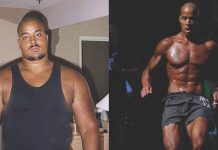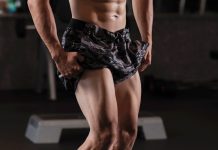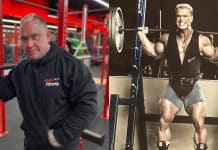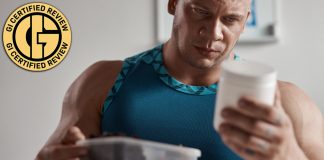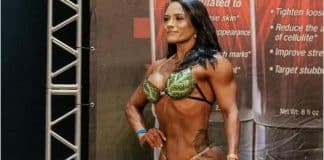
Dumbbell drag curls prevent “cheat reps” for peak biceps contraction.
Curls are excellent exercises for toning your arms. Recent research underscores that arm curls are essential for developing robust arms (1). Barbells and dumbbells are typically the preferred equipment for arm curls. However, kettlebells offer an alternative for those seeking variety, introducing different free weight variations suitable for athletes.
Among the myriad of arm curl exercises, the drag curl stands out for its effectiveness in strengthening the arms. While barbells can be used for this exercise, dumbbell drag curls can help prevent you from cheating during reps, making them particularly beneficial for addressing muscle imbalances between the arms.
This exercise guide offers an in-depth analysis of the dumbbell drag curl, highlighting its significance in achieving well-defined arms. It details the benefits of this exercise and provides a comprehensive step-by-step tutorial on the proper techniques and targeted muscles. Additionally, the guide presents alternative exercises for those looking to diversify their arm-strengthening regimen.
Techniques & Muscles Worked
Although the dumbbell drag curl isn’t popular with athletes, it’s a pretty effective arm isolation exercise. Although it can be challenging because it removes the shoulders from the movement, its limited movement also creates a good biceps contraction since it limits momentum.
Dumbbell drag curls target the biceps, forearms, and brachialis (elbow flexor muscle). They are different from the standard arm curl because the elbows are positioned behind the arms. This creates stronger elbow flexion, which adds width to the upper arm. Below is a step-by-step guide on how to do the dumbbell drag curl.
- Choose dumbbells of the appropriate weights and lift them using an underhand grip. Ensure your hands and feet are shoulder-width apart.
- Next, stand straight while keeping your shoulders down, back straight, and your chest and heads up. This is your starting position.
- Bracing your core, take your elbows back and drag the dumbbells slowly upwards without raising your shoulders. When you reach the top, pause for about 1 or 2 seconds.
- Slowly reverse the motion to the starting position to complete the rep.
- Repeat for your prescribed number of reps.
Benefits
When people think of arm exercises, they think of regular bicep curls, but the dumbbell drag curl is an excellent option, too. This arm-building exercise builds strong and massive arms. Below are some other benefits of doing dumbbell drag curls.
Lesser Load, More Growth
The dumbbell drag curl is suitable for using lower loads for maximum muscle gains. You don’t need the heaviest weights to build your biceps. This exercise eliminates all other muscle groups, especially your shoulders, putting all the tension on your arms, elbow flexors, and forearms, leading to muscle hypertrophy.
Bigger Arms
The dumbbell drag curl is a targeted exercise for the biceps in your arms. However, it also targets your brachialis (a muscle under your biceps). This muscle adds width to your biceps and pushes it out, making it look bigger.
Strengthens Your Elbow Flexors
Doing the dumbbell drag curl works the arms and elbows. This includes all muscles, joints, and tissues surrounding them. The continuous tension on the elbows, joints, and tissues makes them stronger and more resistant.
Carryover to Other Exercises
Performing the dumbbell drag curl targets your arms and elbows, strengthening them. This makes doing other arm training exercises and workouts easier with the proper form, such as pull-ups, a compound movement that uses your biceps as a secondary muscle group.
Core Activation
Doing the dumbbell drag curl activates your core muscles. You’ll use your abs and obliques to stabilize as you find your balance. This improves your posture and helps prevent injuries.
Dumbbell Drag Curl Alternatives
Dumbbell drag curls aren’t as popular as standard curls, but they’re one of the best exercises for building your arms. However, you shouldn’t limit yourself to this exercise to avoid a plateau. This study shows the benefits of integrating other exercises to prevent monotony training (2). Here are some other arm-building routines to try out.
Pull-ups
Pull-ups work the upper body parts like the traps, lats, and shoulder blades. Another vital muscle it targets is the brachialis, which lies directly beneath the biceps. Pull-ups come in many variations, which you can use to vary your routines.
Inverted Rows
The inverted row is a bodyweight movement that works the trap and lat muscles. This exercise also works on the biceps for bigger arms.
Bicep 21s
This is an effective workout routine for building enormous arms. They’re usually great for a finisher, especially when you want to get a pump from your biceps due to the volume. To do biceps 21s, you use a dumbbell or barbell to perform seven curls from the bottom to the midway. Then you do another seven from the midway to the top and, finally, a full curl seven times from the bottom to the top.
FAQs
What do dumbbell drag curls do?
Dumbbell drag curls target your biceps, forearms, and brachialis (a muscle found under the biceps that allows you to flex your elbows). Bigger biceps and brachialis mean bigger and sleeve-ripping arms.
What is the difference between drag curls and normal curls?
Drag curls are arm isolating and limit your movements, thus placing more tension on your biceps with little load. Regular curls have your arms fully extended with a fully loaded weight. The normal curl doesn’t isolate your biceps as effectively because you need your shoulders to stabilize the weight.
Are drag curls beneficial?
Drag curls are beneficial because they provide intensive workouts for your biceps and elbow flexors. This is effective for gaining bigger arms with less load.
Follow us on Instagram, Facebook, and Twitter for more exercise guides!
References
- Coratella, G., Tornatore, G., Longo, S., Toninelli, N., Padovan, R., Esposito, F., & Cè, E. (2023). Biceps Brachii and Brachioradialis Excitation in Biceps Curl Exercise: Different Handgrips, Different Synergy. Sports (Basel, Switzerland), 11(3), 64. https://doi.org/10.3390/sports11030064
- Krzysztofik, M., Wilk, M., Wojdała, G., & Gołaś, A. (2019). Maximizing Muscle Hypertrophy: A Systematic Review of Advanced Resistance Training Techniques and Methods. International journal of environmental research and public health, 16(24), 4897. https://doi.org/10.3390/ijerph16244897



